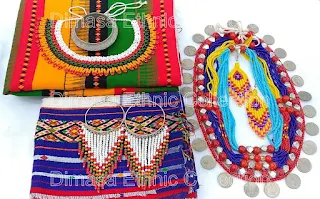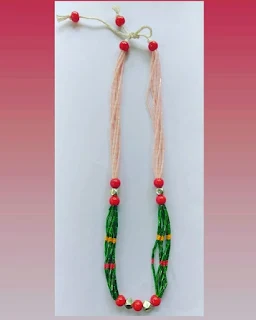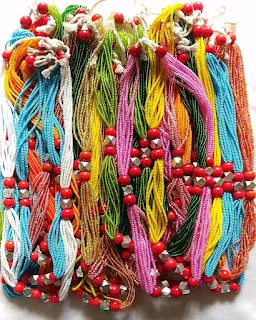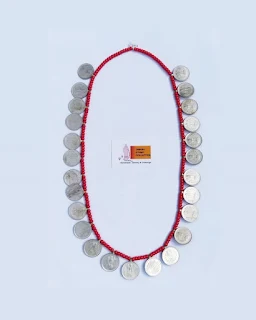 |
| Dimasa traditional ornaments and dresses |
Dimasa male ornaments names
are:
Nowadays,
except for rings, The Dimasa man does not wear any ornaments. In the past, of
course, they put on silver earrings called Kharik and silver iron called
Yaocher.
Kharik is an earring worn by Dimasa men. It is made from copper.
Dimasa female ornaments
names are:
The Dimasa female is very fond of ornaments. Among the important ornaments, they are use necklaces, made of silver pieces and costly seashells, in the past earrings (Khamaothai) are made of gold but nowadays Khamaothai is made of micro-beads in different colors and designs, necklaces made of silver, necklaces made of silver coins (Rangbarsha), pure silver bangle (Khadu), and necklaces made of different kinds with micro-beads.
 |
| Jongsama |
Jongsama in different colors and designs:
 |
| Jongsama different colors |
Jongsama is a traditional necklace worn by Dimasa girls and women. It is made of micro-beads the color pattern of Dimasa traditional dress, Rajamphain Rmai Beren.
 |
| Chandrawal Renbri |
 |
| Rangbarsha |
Rangbarsha is a Dimasa traditional necklace worn by girls and women. It is made from silver coins.
 |
| Rmailik |
Rmailik is made of
colorful micro-beads worn by Dimasa girls and women. It is the combination of two words Rmai
and Lik. “Rmai” means the colorful stripes of orange, yellow, green, black,
blue, and white used in the upper garment like Rijamphain Rmai Beren, and
"Lik" means beaded necklace.
 |
| Shukhep |
The traditional headgear is called Shukhep
in the Dimasa language (Grao-Dima). It is a colorful headgear made with bamboo
sticks worn by Dimasa women.
 |
| Khamaothai |
Khamaothai is an earring
that is a necklace worn by girls and women.
 |
| Khadu (Bangle) |
Khadu is a bangle or circlet worn by women. Khadu is
made from pure silver.
 |
| Phowal |
Phowal is a garland worn by both Dimasa men and women. It is
made of coral and pure silver beads. Red-colored and metal beads become
alternatives due to lack of coral and costly.
Conclusion
In this blog, we have mentioned some things About Dimasa Traditional Ornaments - Jewelry & Ornaments Name with Images. The picture sources are taken from Resmila Thaosen’s Facebook page, Dimasa Ethnic Collection. If you liked this article, then do share it so
that people can get inspired too.
If you liked Dimasa Jewelries/Ornaments and want to buy them then you can buy them.



Comments
Post a Comment